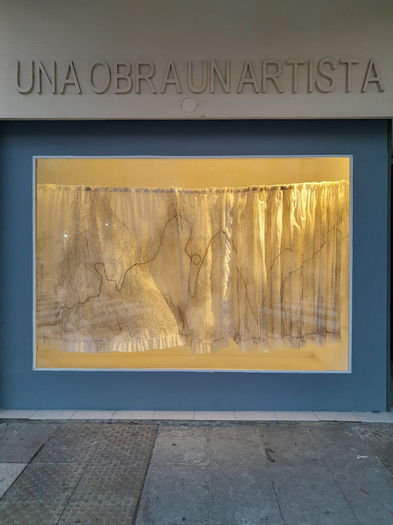BEYOND THE OBVIUS
Site Specific Installation/ Voile curtains with ruffles, graphite ando pressed charcoal, steel wire and fan.
“Because not all truths are meant for every ear, nor can every lie be recognized as such by every pious soul.”
-Umberto Eco, The Name of the Rose (1980)
There are truths so evident that we often—though not necessarily by choice—fail to see them. They are so close to us, so forcefully present, that our gaze passes right over them, seeking something deeper, another layer. And in that attempt to investigate, to see beyond the obvious, we embark on an endless race toward uncertainty.
Because when we search for what is not there, when we ignore what exists, and when the race to challenge what is clearly revealed takes hold, despair takes the lead. We then try to reconstruct and assign meaning to that which has none.
The curtain-like fabrics veil a space by doing precisely what curtains do. Their elegance, subtlety, and seductive transparency initially captivate the viewer with their gentle, fluid movements and their promise of secrets hidden behind them—secrets we might uncover.
Yet therein lies the enigma: the work’s revelation does not lie beyond the first impact, beyond what our perception does not overlook but our mind almost instantly chooses to ignore.
I agree with Umberto Eco when he suggests that not all truths are meant to be heard by everyone. Because they require a different kind of openness—a willingness to hear something perhaps unimaginable. It demands we stop looking “beyond” and instead become present in the “here and now,” confronting and silencing speculation.
And that truth often stands plainly before our eyes, cloaked in overwhelming silence, waiting to be seen.
Not every gaze—just like not every ear—is capable of looking within the obvious. Some will get lost in a labyrinth of interpretations and remain there, searching for a way out like a mythical character.
Other gazes will shift perspective, refusing to be caught in obsessive analysis. These may come closer to the mystery before them.
But only a few will instantly grasp the proposal of artist Carolina Di Paola—those rare ones who see the forest beyond the trees almost effortlessly. They will enjoy a different kind of narrative—in form, medium, and concept.
And it is precisely there that drawing will emerge, where the line becomes the protagonist and the author of a story unfolding in a different kind of space, generating new questions in the viewer and challenging how we see—and judge—what we perceive.
In that simple premise, the invisible, silent, ethereal, infrathin foreground will appear. And with it, a new sensory and reflective experience—perhaps the most valuable gift that art can offer us.
Guest Curator: Lic. María Carolina Baulo, September 2024
This artwork was selected for 1O1A Una Obra Un Artista, 2022, and it was exposed at the end of 2024





